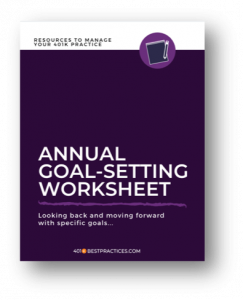 As you plan your strategies for growth, there are three things you should do to increase your opportunity for success in your 401k practice.
As you plan your strategies for growth, there are three things you should do to increase your opportunity for success in your 401k practice.
One: Set Goals
The first one is to set goals. Only 3% of adults have clear, written, specific, measurable, time-bounded goals, and by every statistic, they accomplish ten times as much as people with no goals at all.
As you begin your goal-planning activity, answer these questions:
- What was your biggest accomplishment during the last 12 months? (“Study the past if you would define the future.” ~ Confucius)
- Looking back over the past year, what would have done differently? (“More people would learn from their mistakes if they weren’t so busy denying them.” ~ Zig Ziglar)
- What is our #1 business goal for the next 12 months…If you could accomplish only one thing this year, what would it be? (“You cannot change your destination overnight, but you can change your direction overnight.” ~ Jim Rohn)
- Why is this goal important to you and what do you think is needed to accomplish this goal? (“Motivation is what gets you started. Habit is what keeps you going.”)
Two: Include Goals that Mean Something to Your Client
Since being a 401k plan advisor is not about you, include in your goals what impact or difference you hope to be able to measure in the lives of the participants you serve. Think about what ruler will you use to measure success this year and how will you define and explain that to your clients and prospects?
Here are some activities to get you thinking:
- Identify one success or activity from this past year that made an impact on helping participants and plan sponsors achieve their goals for a successful retirement plan? (“God calls us not to be successful but to be significant. When we focus on Significance, success is often part of the package.” ~ Tom Ziglar)
Here are some examples of what you might list: Implemented auto escalation on 3 plans affecting 3200 participants in all; Provided education or advice to 500 employees through 18 group meetings, 85 individual consultations, etc.; Negotiated expenses for a plan that reduced costs by 30% and equates to potentially $300 more a month for participants in retirement; Increased deferral rates or % on track for successful retirement; Reduced workload of plan sponsors by changing recordkeepers, etc.
- List at least one goal that, when accomplished, would directly impact successful participant outcomes. (“You make a living by what you get; you make a life by what you give.”)
Here are some examples of what you might list: Increase average deferral rate from 4% to 6% on the plans I service; Enroll 20% of non-participating (but eligible) participants across all plans I service; Implement re-enrollment and get 80%+ allocation into target-date funds; Benchmark 100% of the plans I service to help plan sponsors ensure their fees are reasonable, etc.
Three: Articulate your Value through the Successful Achievement of Your Goals
Review the various ways you can articulate your participant-focused goals to differentiate yourself when you talk to plan sponsors – how you show real, measurable, improvements you make in the client relationships you have.
You may not have thought about how your activities and successes directly impact participants, but as a 401k advisor, the services you offer generally work for the greater good of the plan and ultimately the benefit of plan participants.
You should track your service activities and results throughout the year and present this material to plan sponsors during the annual plan review meeting. You should also use this data when talking to prospects to differentiate yourself and demonstrate your commitment to achieving successful outcomes. The following is a partial list of ways you could track and articulate the value you bring to the table.
- Identify how many education meetings you conduct each year
- List the education topics delivered to participants
- Identify how many individuals you meet with one-on-one
- What % of participants are in target-date or asset allocation funds on the plans you service
- How many individuals are on-track for a successful retirement (according to data analyzed by reports offered by companies like Investment Horizons or Perspective Partners)
- How many time’s you’ve facilitated the removal of unnecessary services
- Incidents where you’ve negotiated fees to better align with industry standards
- Situations where you’ve quarterbacked a move to a new platform that was more user-friendly
- Number of Investment Committee members you’ve trained on ERISA fiduciary roles and responsibilities
- Percentage of plan’s you’ve provided benchmark data for to help ensure reasonableness of fees
- Number of enrollment meetings held or # of new enrollments
- Percentage of plans that have implemented auto enroll or auto escalation
- Average match percentage or match scale on the plans you service if above average
- …And the list could go on and on.
Think about the services you offer, and describe them to show the benefit your clients gain. Track and share data that works towards achieving more successful participant outcomes.
You can download the complete planning worksheet here and I encourage you to go through the complete exercise; set goals, include goals that directly benefit your clients, and track your goals so you can include your results as part of your value proposition. I wish you a most successful year!
